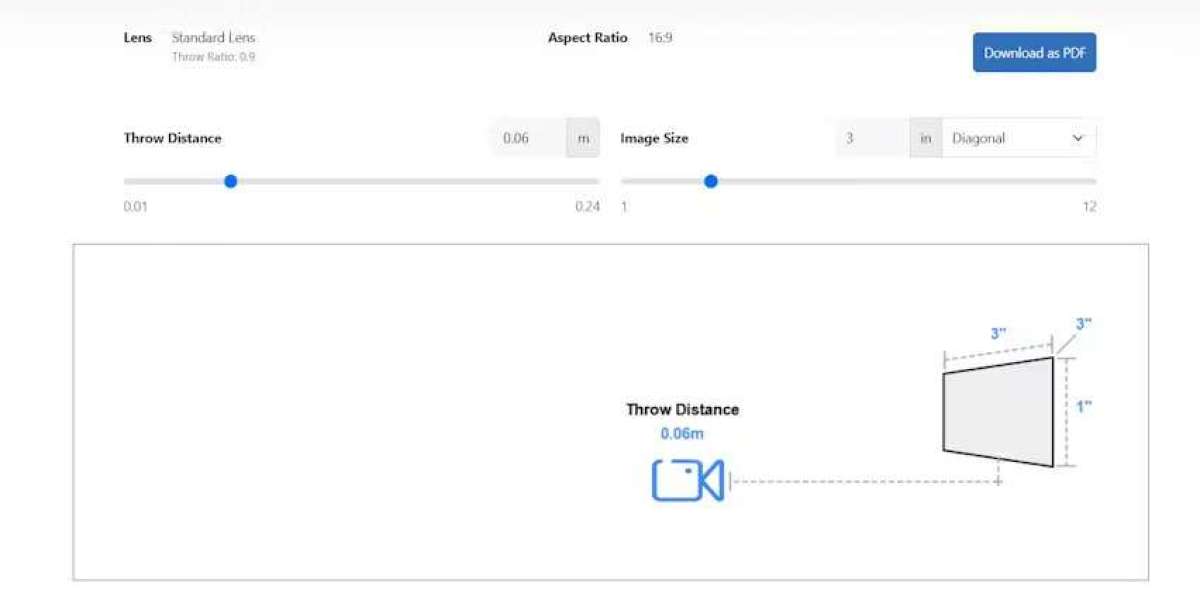Choosing the right projector for a classroom involves more than just selecting one with high brightness or resolution. One of the most critical factors for a successful classroom setup is the Projector Throw Ratio. Throw ratio determines how far the projector needs to be from the screen to display an image of the desired size. Selecting the correct throw ratio ensures that students can clearly see presentations, videos, and instructional material without distortion or awkward placement.
Understanding Projector Throw Ratio
Before discussing the best throw ratio for classrooms, it is important to understand what Projector Throw Ratio means. Throw ratio is the ratio of the distance from the projector to the screen to the width of the projected image. For example, a throw ratio of 1.5:1 means that for every 1.5 feet of distance, the projector produces an image 1 foot wide.
Knowing the throw ratio helps educators and IT teams determine where to position the projector and which screen size will fit comfortably within the classroom space. Incorrect throw ratio can lead to images that are too small, too large, or misaligned with the screen, which can distract students and reduce learning effectiveness.
Ideal Throw Ratios for Classroom Environments
Classroom projectors are typically used in spaces ranging from small seminar rooms to large lecture halls. The best throw ratio depends on the size of the room, the screen, and how close students are seated to the display.
Short Throw Projectors: Short throw projectors have ratios between 0.4 and 1.0. These projectors are ideal for small to medium classrooms where the projector needs to be placed close to the screen. Short throw projectors minimize shadows on the screen when instructors move around and reduce the risk of students being blinded by the projector light.
Standard Throw Projectors: Standard throw projectors have ratios between 1.2 and 2.0. They are suitable for medium to large classrooms where the projector can be positioned further from the screen. Standard throw projectors allow for a more flexible seating arrangement but require sufficient distance from the screen to achieve the desired image size.
Ultra Short Throw Projectors: Ultra short throw projectors have ratios below 0.4 and can produce large images from a few inches away from the screen. These are particularly useful in classrooms with limited space or where wall-mounted projectors need to be positioned close to students.
Calculating the Right Throw Distance
Once you know the throw ratio of your projector and the width of your classroom screen, you can calculate the ideal placement. The formula is simple:
Distance from Projector to Screen = Throw Ratio × Screen Width
For example, if your classroom has a 10 foot wide screen and you are using a projector with a throw ratio of 0.8:1, the projector should be placed 0.8 × 10, which equals 8 feet from the screen. This ensures that the image fills the screen properly without overspill or black borders.
Benefits of Using the Correct Throw Ratio
Using the correct throw ratio in a classroom setting provides several advantages:
Improved Visibility: Students at the back of the room can see the image clearly without straining their eyes.
Reduced Shadows and Glare: Short and ultra short throw projectors minimize shadows cast by instructors and reduce glare for students seated near the projector.
Better Image Quality: Correct throw ratio ensures the image is sharp and well-proportioned, avoiding distortion that can occur when the projector is too close or too far from the screen.
Flexible Classroom Layouts: Knowing the throw ratio allows for more flexibility in projector placement, accommodating various seating arrangements and screen sizes.
Additional Considerations for Classrooms
While throw ratio is essential, there are other factors to consider for optimal classroom projector performance:
Brightness: Classroom projectors should have sufficient lumens to overcome ambient light. A minimum of 3000 lumens is recommended for most classrooms, with larger or brighter rooms requiring more.
Resolution: Full HD resolution ensures that text and images are clear, which is especially important for presentations, videos, and detailed diagrams.
Mounting Options: Ceiling mounts or wall mounts help keep the projector stable and positioned correctly, which is particularly important when using short or ultra short throw projectors.
Connectivity: Ensure the projector supports HDMI, USB, or wireless connections for laptops, tablets, and other classroom devices.
Common Mistakes to Avoid
Educators and IT teams sometimes make mistakes when selecting or setting up projectors in classrooms:
Ignoring Throw Ratio: Placing the projector without considering throw ratio can lead to images that are too large or too small for the screen.
Over-relying on Keystone Correction: Digital keystone correction can fix image alignment but may reduce image quality. Physical placement based on throw ratio is preferable.
Choosing the Wrong Screen Size: A screen that is too small or too large for the projector throw ratio can distort the image or reduce visibility.
Neglecting Room Layout: Furniture, ceiling height, and viewing angles can affect projector placement. Proper planning ensures everyone can see the image clearly.
Final Thoughts
Selecting the best Projector Throw Ratio is critical for effective classroom projection. Short throw projectors are ideal for small to medium classrooms, standard throw projectors work well in larger spaces, and ultra short throw projectors are perfect for compact rooms with limited mounting options.
By calculating the correct throw distance, considering screen size, and factoring in room layout, educators can ensure that every student sees a clear, well-sized image. The right throw ratio not only enhances visibility and engagement but also contributes to a professional and distraction-free learning environment.
A well-planned projector setup with the correct throw ratio transforms any classroom into an effective space for teaching, learning, and collaboration.
Read more: https://zekond.com/read-blog/265410














